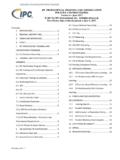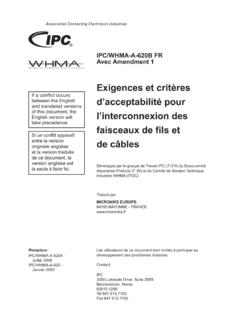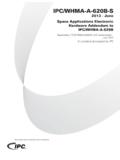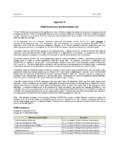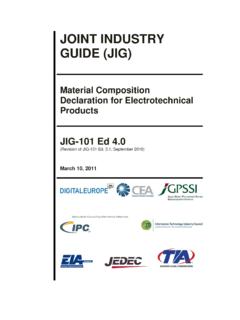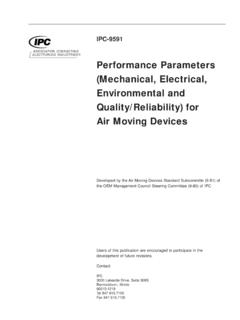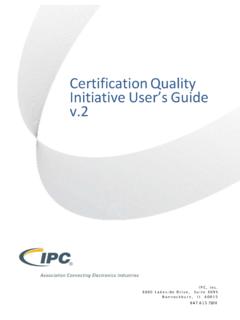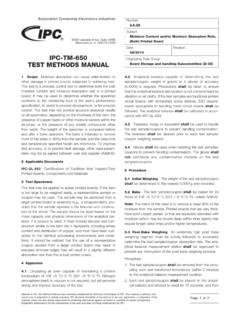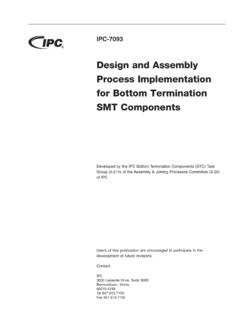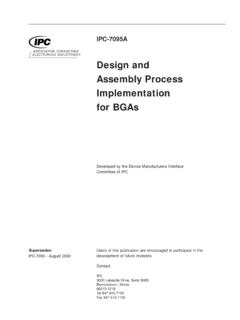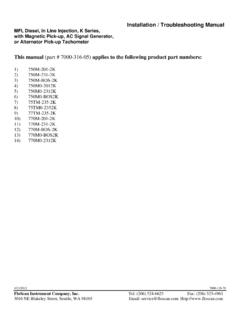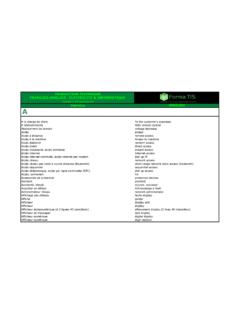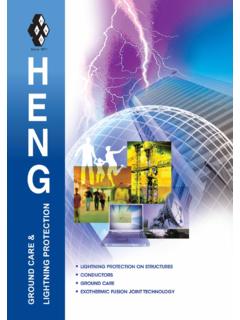Transcription of IPC-TM-650 High Speed/High Frequency Test Methods TEST ...
1 SummaryThis method is for measurement of relativepermittivity ( r) and dissipation factor or loss tangent (tan )ofcircuit board substrates under stripline conditions. Measure-ments are made by measuring resonances of a length of strip-line over a wide Frequency range from below 1 GHz to about14 GHz(1,2). The method permits a wide variety of specimenconfigurations, varying in dielectric thickness, width of centerconductor, and use of clad or laid up conductor foil(3). Sensi-tivity to differences in tan are enhanced by the ability toadjust the degree of coupling to the resonator by adjusting anair gap between probes and the resonator ends. Many of theprinciples used in IPC-TM-650 , Method , are applied inthis TerminologyTerms used in this method include:Complex Relative Permittivity The values for relative permit-tivity and dissipation factor considered as a complex Dielectric constant (see IPC-T-50) or relative per-mittivity.
2 The symbol used in this document is r. or arealso sometimes Permittivity A dimensionless ratio of absolute per-mittivity of a dielectric to the absolute permittivity of a Tangent Dissipation factor (see IPC-T-50), dielectricloss tangent (see ). The symbol used in this document istan . LimitationsThe limitations in described in should be measured effective permittivity for the resonatorelement can differ from that observed in an the application is in stripline and the line width toground plane spacing is less than that of the resonator ele-ment in the test, the application will exhibit a greater compo-nent of the electric field in the X, Y plane. Heterogeneousdielectric composites are anisotropic to some degree, result-ing in a higher observed rfor narrower lines in an application may also differ from the testin the fraction of substrate electric field component in the X, stripline assemblies have air excluded betweenboards and thus tend to show greater rvalues than would beobtained with this method using specimen types A or, tolesser extent, B, as discussed in with IPC-TM-650 , Method , with specimentype A, or, to a lesser extent, with B (see ), we expect themethod to show a downward bias in measured r.
3 This iscaused by the electric field crossing clamped dielectric-conductor interfaces with air included in the surface specimen type B, C, or D, the method shows anupward bias in measured tan . This is caused by the surfaceroughness and/or surface treatment of the clad copper foilrequired for adequate adhesion to the to IPC-TM-650 , Method , bothdone with computer automated data collection, this methodrequires a greater degree of operator skill and more time toprepare specimens and perform sensitivity of the method to differences in rofspecimens should be superior to that of IPC-TM-650 , since the specimen comprises all of the dielectricaffecting the method is known to be more sensitive to differ-ences in tan than IPC-TM-650 , Method We believethe ability to adjust the degree of probe-to-resonator couplingto a low enough value that Qloadedis close to Qunloaded( )
4 Makes this method is expected to lend itself to use of stablereferee specimens of known electric properties traceable toNIST (National Institute of Standards and Technology). Applicable DocumentsIPC-MF-150 Metal Foil for Printed Wiring ApplicationsIPC-TM-650 Method , Stripline Test for Permittivityand Loss Tangent (Dielectric Constant and Dissipation Factor)at X-Band2215 Sanders RoadNorthbrook, IL 60062-6135 IPC-TM-650 TEST Methods Test for Complex Relative Permittivity ofCircuit Board Materials to 14 GHzDate3/98 RevisionOriginating Task GroupHigh Speed/High Frequency Test MethodsSubcommittee (D-24)Material in this Test Methods Manual was voluntarily established by Technical Committees of the IPC. This material is advisory onlyand its use or adaptation is entirely voluntary.
5 IPC disclaims all liability of any kind as to the use, application, or adaptation of thismaterial. Users are also wholly responsible for protecting themselves against all claims or liabilities for patent referenced is for the convenience of the user and does not imply endorsement by the CONNECTINGELECTRONICS Test SpecimenSpecimen length corresponds to anavailable fixture length L. Longer L values enable lower mini-mum resonant frequencies to be achieved. L is also the lengthdimension of the copper plates described in Four types ofspecimens can be used for this method, as shown in Type ATwo mm wide by L long cards etched freeof copper cladding. These are placed on either side of a cen-ter strip of smooth copper foil of specified thickness and widthand will be assembled between mm wide by L long cop-per foil Type BOne mm wide by L long card with cladcopper on one side and copper etched off the other side.
6 Anda second card of matching size with clad copper on one sideand copper etched off the other side except for a centeredstrip of specified width extending to both ends of the copper free surface of the first card is assembled againstthe etched strip of the other to form the stripline Type CTwo mm wide by L long cards with cladcopper on one side and copper etched off the other sideexcept for a centered strip of specified width extending toboth ends of the card. The etched strip surfaces of both cardsface together to form the stripline Type DOversize cards similar to type B are bondedtogether with a selected bonding film and then trimmed to sizeto form the stripline resonator assembly. This could be a testcoupon cut from a bonded stripline circuit board types B, C, and D, the specimen card should first be pre-pared with about 5 mm or more excess length.
7 Wide pressuresensitive adhesive (PSA) tape can be used to mask theground plane side, and a narrow PSA tape can be used tomask for the centered strip before etching off exposed cop-per. Trimming the excess length after etching removes anyundercut areas at the ends. Trimming to length should bedone in a way that leaves the end surfaces with sharp edgesand no conductor edge distortion or smears over that specimens clamped between paper-phenolic lami-nate drill-entry boards is an advised method for finishing theend A specimens with untreated smooth copper foil will pro-vide the most accurate values for tan , but will tend to havea low bias on r. Type C eliminates all clamped interfaces withthe air layer between the dielectric and the conductor to givethe most accurate rvalue but, with the copper surfacestreated for adhesion, tends to have a high bias on dissipationfactor.
8 Type D gives a good measure of practical performancein an Suggested Electronic ApparatusThe principal com-ponents required for the test setup consist of the test fixturedescribed in combined with the components described , Figure 2, Type A and Type B, or preferably with the sys-tem in , Figure 2, Type A Test Setup for Computer Automation of DataThisrequires a microwave signal source, an accurate means ofmeasuring the signal Frequency , an accurate means fordetecting power level, and an accurate method of determin-ing Frequency values above and below the resonant frequencyat the half-power level for the test fixture loaded with following components or equivalent, properlyinterconnected, can be used most effectively with a computercontrol program for automated testing.
9 Sweep Frequency Generator Mainframe HP8350B RF Plug-In, to 20 GHz HP83592A Power Splitter HP11667A Automatic Frequency Counter HP5343A Source Synchronizer HP5344 AObtained as an interconnected assembly with the counter. Coaxial cables and adaptersIPC-125551-1 Figure 1 Exploded End Views of Stacked SpecimenTypes A, B, C and D (See ) with Copper Foil ThicknessExaggerated and Including the Copper Plates (See )and Steel Bars (See ) of the Test for Complex Relative Permittivity of Circuit BoardMaterials to 14 GHzDate3/98 RevisionPage2of11 10 dB Attenuator HP8491B Programmable Power Meter HP436A Power Sensor HP8484A with 70 to 10 dBm range IEEE 488 (GPIB) cables Controlling computer with GPIB interfaceThe above equipment is connected as explained in , and as illustrated in Figure 2, Type RF ConnectionsThe power splitter connectsdirectly to the RF plug-in output.
10 One output of the splitterconnects by RF cable to the counter input. The other outputis connected by RF cable to the attenuator which connects toone of the test fixture probe Control ConnectionsConnections betweencounter and synchronizer are provided as specified by themanufacturer. The FM output from the synchronizer connectsby BNC to the FM input on the sweeper. GPIB cables connectin parallel to the sweeper, synchronizer, power meter, andcomputer Other ConnectionsThe power sensor is con-nected to the other probe of the fixture, and its special cableconnects into the power microwave signal source must be capable of pro-viding an accurate signal. During the required time period andrange of Frequency needed to make a permittivity and losstangent measurement, the source must provide a leveledpower output that falls within a dB range.
